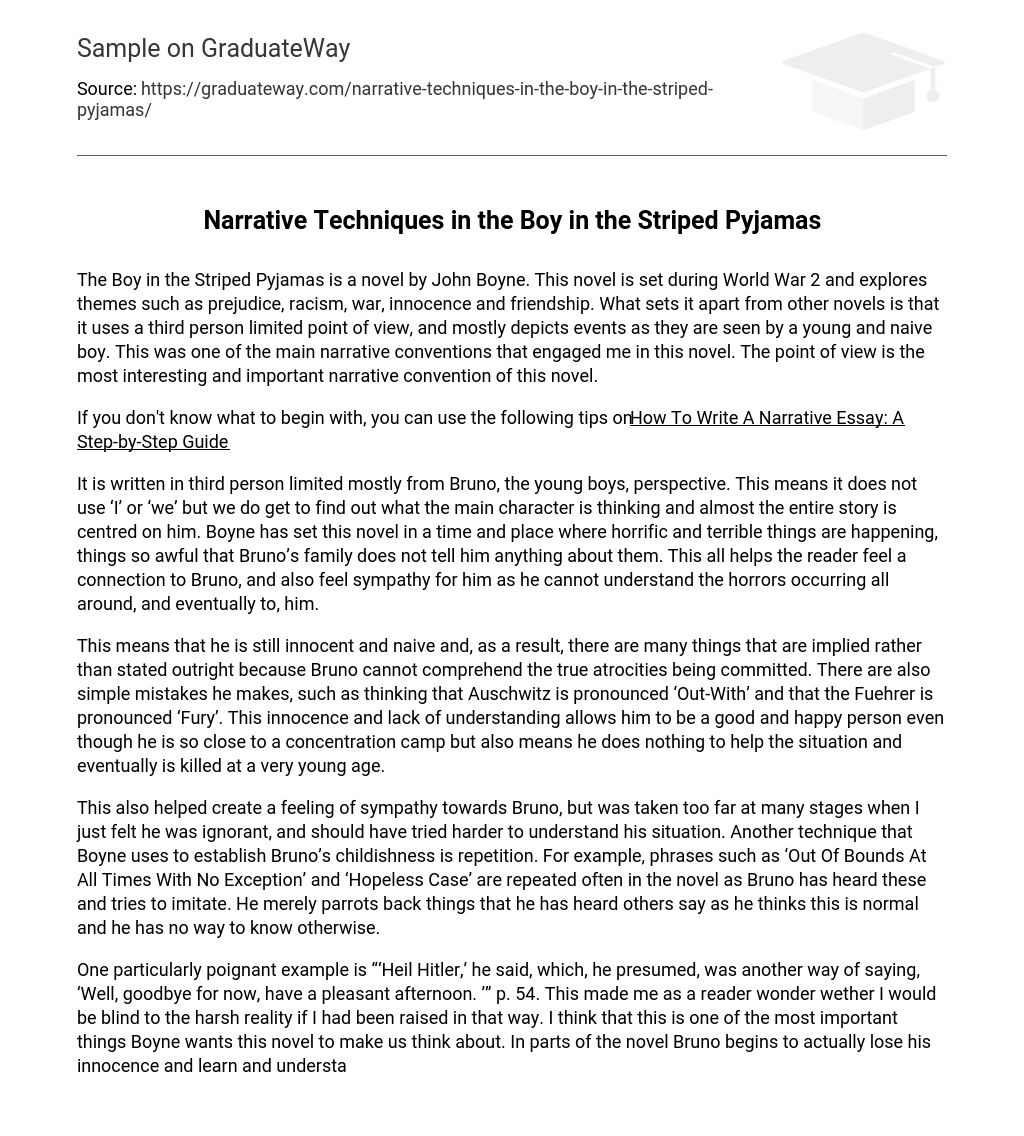The Boy in the Striped Pyjamas is a novel by John Boyne. This novel is set during World War 2 and explores themes such as prejudice, racism, war, innocence and friendship. What sets it apart from other novels is that it uses a third person limited point of view, and mostly depicts events as they are seen by a young and naive boy. This was one of the main narrative conventions that engaged me in this novel. The point of view is the most interesting and important narrative convention of this novel.
If you don’t know what to begin with, you can use the following tips on How To Write A Narrative Essay: A Step-by-Step Guide
It is written in third person limited mostly from Bruno, the young boys, perspective. This means it does not use ‘I’ or ‘we’ but we do get to find out what the main character is thinking and almost the entire story is centred on him. Boyne has set this novel in a time and place where horrific and terrible things are happening, things so awful that Bruno’s family does not tell him anything about them. This all helps the reader feel a connection to Bruno, and also feel sympathy for him as he cannot understand the horrors occurring all around, and eventually to, him.
This means that he is still innocent and naive and, as a result, there are many things that are implied rather than stated outright because Bruno cannot comprehend the true atrocities being committed. There are also simple mistakes he makes, such as thinking that Auschwitz is pronounced ‘Out-With’ and that the Fuehrer is pronounced ‘Fury’. This innocence and lack of understanding allows him to be a good and happy person even though he is so close to a concentration camp but also means he does nothing to help the situation and eventually is killed at a very young age.
This also helped create a feeling of sympathy towards Bruno, but was taken too far at many stages when I just felt he was ignorant, and should have tried harder to understand his situation. Another technique that Boyne uses to establish Bruno’s childishness is repetition. For example, phrases such as ‘Out Of Bounds At All Times With No Exception’ and ‘Hopeless Case’ are repeated often in the novel as Bruno has heard these and tries to imitate. He merely parrots back things that he has heard others say as he thinks this is normal and he has no way to know otherwise.
One particularly poignant example is “‘Heil Hitler,’ he said, which, he presumed, was another way of saying, ‘Well, goodbye for now, have a pleasant afternoon. ’” p. 54. This made me as a reader wonder wether I would be blind to the harsh reality if I had been raised in that way. I think that this is one of the most important things Boyne wants this novel to make us think about. In parts of the novel Bruno begins to actually lose his innocence and learn and understand more about the world around him.
For example, when he is talking to Maria about his father and she starts to speak to him about her earlier life he “realized for the first time that he had never fully considered her to be a person with a life and a history of her own,” p. 60. This process is not fast enough as this innocence still leads to his early death in a gas chamber. However, he thinks that he is just going on a march while he was trying to help his friend, and this means that he is not afraid. His innocence acts like courage, and shields him from fear while placing him in danger.
There are also symbols and comparisons made in the novel. Mostly these are during interactions between Bruno and Shmuel, and often they are very unrealistic, and do not further the plot but instead are there just to make a point. For example, Bruno and Shmuel find that they were born on the very same day, and Bruno remarks “We’re like twins,” p. 110. This is not supposed to be realistic, it is supposed to show the parallel between these children and that they could have just been born to different parents and had massively different lives.
I think Boyne is trying to show that it is senseless to separate these people and treat one as sub-human when they are very similar to one another and Shmuel has done nothing wrong. The fence that separates them is symbolic as on each side there sits a very similar nine-year old boy, but they are not allowed to cross over and the things that happen on one side are massively different to those that happen on the other. It is as if the fence is a distorted mirror, showing the same person but in diametrically opposed worlds.
The Boy in the Striped Pyjamas is a novel that manages to delve into one of history’s darkest hours, but still remains in many ways, endearing and heart warming. It does this through use of powerful narrative techniques such as symbolism and a very interesting point of view. It explores a variety of very different themes, such as and war and friendship, prejudice and innocence, which allows Boyne to show us this time from a different perspective. This is what makes it really affect the reader, and will mean its message will live on for generations.





